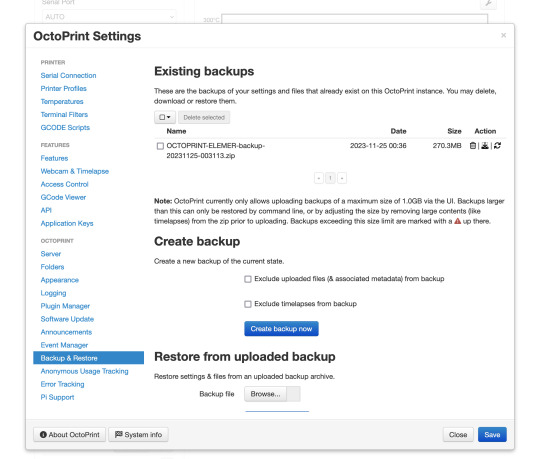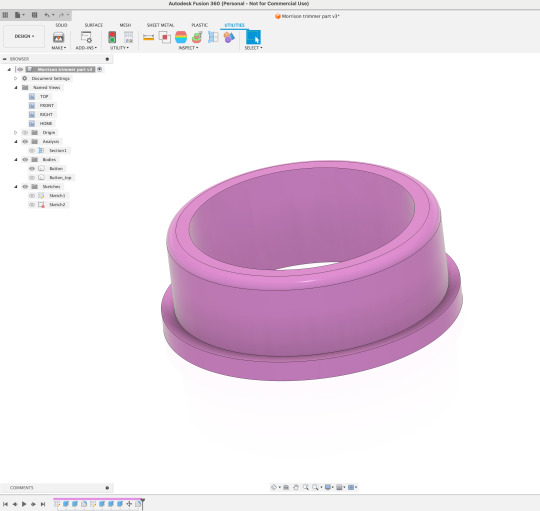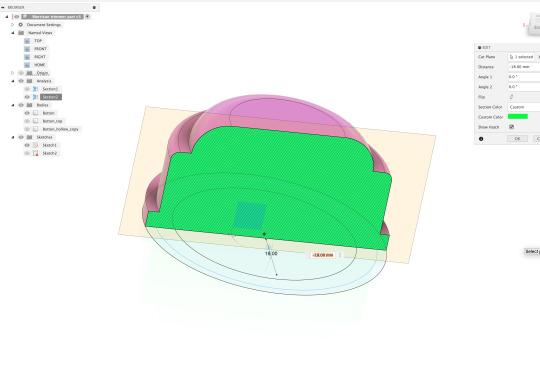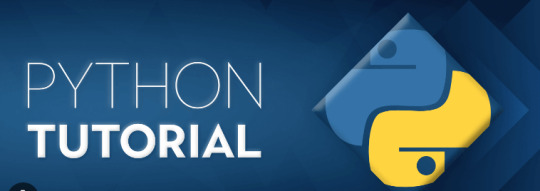#virtualenv
Explore tagged Tumblr posts
Text
Create python3 virtual env
python3 -m venv env
0 notes
Text
score!! 64 results. lol
#tütensuppe#im at least expecting the overall quality to be better than with [redacted]#i feel like i did a million things today but did i get anything done? nah#recent issue: have to set up python virtualenv on this one server that doesnt have internet access? i think?#so package installation is not working
0 notes
Text
Man goes to the doctor. Says he's frustrated. Says his Python experience seems complicated and confusing. Says he feels there are too many environment and package management system options and he doesn't know what to do.
Doctor says, "Treatment is simple. Just use Poetry + pyenv, which combines the benefits of conda, venv, pip, and virtualenv. But remember, after setting up your environment, you'll need to install build essentials, which aren't included out-of-the-box. So, upgrade pip, setuptools, and wheel immediately. Then, you'll want to manage your dependencies with a pyproject.toml file.
"Of course, Poetry handles dependencies, but you may need to adjust your PATH and activate pyenv every time you start a new session. And don't forget about locking your versions to avoid conflicts! And for data science, you might still need conda for some specific packages.
"Also, make sure to use pipx for installing CLI tools globally, but isolate them from your project's environment. And if you're deploying, Dockerize your app to ensure consistency across different machines. Just be cautious about Docker’s compatibility with M1 chips.
"Oh, and when working with Jupyter Notebooks, remember to install ipykernel within your virtual environment to register your kernel. But for automated testing, you should...
76 notes
·
View notes
Text
elmesélem, mert látom érdekel
Van nekem egy fűnyíróm, illetve kettő, de a másik az elég hassle free, elemes. De Ez. Ez benzinges damilos fűkasza vagy mi a neve (line trimmer, weedeater, bushcutter, whatever) és amúgy nincs vele baj brummog és pörgeti (vagy ahogy unokaöcsém mondaná: pörgettye!) a damilt, szóval működik. De. Van neki a pörgettyűje közepén egy ilyen gomb-izé, ami, ha a földhöz csapkodod a masina elejét (Tap 'N Go), kienged még több damilt az elkopott, leszakadt helyett. Na ez a gomb-izé ez a használatban elvásott, elkopott, a teteje lemállott, így a földhözcsapkodás nem működik már. Na jó a csapkodás igen, csak nem lesz tőle hosszabb a damil. Ez, az múgy is utálatos fűnyírás élményén csak ront.
Na, gondoltam magamba' ennek van gyárja, majd veszek bele másik plasztik bigyót mibe kerülhet az, legott írtam is a gyártónak, hgoy hellóbelló, monnyad meg a cikkszámot vagy valami és már rendelem is az egyetlen alkatrészt ami _hótziher_ h elkopik a(z amúgy oké) szarotokon. Veszek hármat, évekre le van tudva. Az a kis izé a piros körben, na az az.

Kaptam vissza egy cirkalmas levelet, hogy nagyon örülnek, hogy elégedett vagyok a termékkel, de ez a filléres plasztik bigyusz bizony külön nem cikkszám, csak az egész damilos fej-bigyó egyben az, rendeljem azt. Anúgy nem vészesen drága, csak megsértődtem (ami ingyen van) hogy minek nekem egy egész új fej amiből csak ez az egy bütyök kell. Amúgy a damilcserebere része nem a legokosabb, a Husquarna sokkal jobb ebben, de a husky 10 munkaóra után meghalt. Ezt a szart online csak Invercargillból tudom megrendelni, akasszátok fel magatokat, van nekem 3D printerom, majd csinálok én magamnak ilyet, ha elvásik, printolok újat. Easy as.
Izé, szóval az van, hogy egy OctoPrintet futtató RPI volt ráakasztva a printerre, de a történelem fordulatai miatt az RPI kellett máshova, a printer is kicsit kiment a napi-heti használatból és bement a sarokba, de hát nem vagyunk állatok, hogy SD kártyán szaladgáljunk a gcode-al egyből kiokoskodtam, hogy végül is van itt egy öreg laptop, csak ül a polcon, de amúgy nincs baja, arra feldobok egy Octoprint, az majd USB-n megizéli a printert és kész. Aha.

A masina egy 2015-ös MB Air amin Monterey fut, mi baj lehet? A töltője is meglett egy óra alatt, egy másik alatt meg updételte magát amennyire tudta. Azt is mondja, hogy vigyem az akkuját szervizeltetni, de pár órát kibír azért. Erre nem érünk rá most, dolog van. Gyorsan elolvastam hogy kell OctoPrint tenni a macOS-re, nem bonyi, itt el van mesélve, töviről hegyire.
Miután ezt a laptopt a gyerek használta az isiben, nincs rajta semmi, gyári installt csináltam rajta amikor megkapta. Ezért elébb kell egy Xcode-ot telepíteni theát, sebaj, pikkpakk. Ja, nem, a mostani Xcode nem megy a Montereyen, kell egy régebbi változat, de azt csak akkor kap az ember, ha feliratkozik apple fejlesztőnek. Voltam én már mindenféle, ez is belefér, feliratkoztam. Találtam egy régi verziót (a 13-as jó) leszedtem a tíz gigát, kicsomagoltam, feltelepítettem. Kell még command line tools, azt is. Eltartott egy ideig, de sebaj, heg nélkül gyógyul.
Aztán kell egy Python, úgyhogy - követve a javallatokat - felinstalláltam a HomeBrew-t, azzal felraktam a Pythont, örvendeztem. Aztán kell egy virtualenv, de az ugye már nem kunszt, van pip, azt is felbigyóztam.

Aztán felraktam az OctoPrintet ami eleinte nem indult el, aztán meg de, nem értem se azt miért nem ment, se azt mitől megy most, de nem is érdekel, lényeg, hogy fut meg megy a kis webszervere is, lehet nyomkorászni az UI-ját. Igen a printert Elemérnek hívják.
Ezek után rájöttem, hogy fingom sincs milyen beállításokkal ment az OP a RPI-n, úgyhogy beléptem az RPI-be ami mással foglalkozik egész nap, megizéltem az izéjét, hogy két webszerver is fusson rajta anélkül, hogy idegesítenék egymást, így elértem a régi OP-t a régi, jól bevált settingeket tudtam backupolni, a backupot leszedni, rárakni egy USB-drájvra. (amit kerestem egy fél órát, ki használ ilyesmit). Ugyanezt megcsináltam a prusaslicerrel is, ha kéne a printert rángató szaron valamit kicsit újraszlájszolni meglegyen, de az nem volt nagy kunszt, config ki, config be, szivárványok, egyszarvúak. Aztán rákötöttem az öreg macet a printerre, látták és szerették egymást, minden fasza, elő a sublert.

A vacak elvásott darabot lemértem, Fusion-ban rajzoltam egy ugyanolyat mint emlékeim szerint eredeti állapotában ez volt (na jó, nem emlékszem jól, de mindegy a méret stimmol és nem egy komplikált alkatrész), stl ki, stl octoprintbe be, nyomtassunk. Az első print egy fos, a filament eléggé rottyon van, de sebaj, legalább a méretet le tudtam csekkolni, szépen passzol a fűnyíróba.

Nyilván amíg ezt gépeltem már eszembe jutott, hogyan lehetne ezt sokkal jobban csinálni, majd mindjárt újratervezem az egészet, mert nekem nem kell költséget csökkenteni, mint a gyárnak és nem számít, hogy 11g vagy 20g anyag megy bele a darabba, nem kell, hogy üreges legyen, csinálok jó masszív, tömört valami sűrű vagy full infillel.

Persze az egész kaland nem tartott volna ennyi ideig, ha van összerakva egy hálózatra kötött printer, vagy csak rájövök, hogy be van-e az sd kártya olvasó konfigurálva azon az SKR3 Mini E3 printer control boardon amire lecseréltem valamikor a gyári creality-t. Meg találok egy SD kártyát amit éppen nem használ semmi. De halvány lila fingom sincs, hogy amikor a firmware-t feltettem akkor megcsináltam-e ezt, sose kellett. (érdekes módon 3 éve a v1.2 board akkor 28 usák dollár volt, a mostani v3 meg hatvan. (le van ócsítva most 32-re de sokkal többet tud mint a v1.2 anno. Dual Z-driver, jobb hűtés, 3fan viszont ugyanazok a TMC2209 motorvezérlők vannak benne)).
Na mindegy, végül ilyen lett, nagyon szépen passzol, bár kicsit nehéz, 59.9g lett (phat boi) ami lehet, hogy kicsit zavarni fogja a masinát. Bár elég közel van a forgás közepéhez, úgyhogy úgy döntöttem, megbírja ez, megbírja. Most sajnos nem tudopm kipróbálni, mert nincs kedvem rossz az idő, de majd tán holnap.

71 notes
·
View notes
Note
Modern versions of Python include py, which is a launcher that lets you run different versions of Python. If you install virtualenv as well then you can make virtual environments for with different versions of Python, which makes using others' code wildly easier!
If you want to get write your own code then I'd also suggest installing hatch and using it to setup your project. It can automate a bunch of the environment stuff for you and also useful tools like linters or doc generators.
😅 sorry if this wasn't what you were looking for. I hope you're having a good day!
Yo they made technobabble from scifi real?
#thank you for sharing#despite not understanding much of any of this#hope you have a good day too friend
2 notes
·
View notes
Link
Cómo Instalar virtualenv y virtualenvwrapper en Unix/Linux #Linux
0 notes
Text
Encountering issues with Python version control on macOS? Discover how to master pyenv and virtualenv with our detailed guide. Access it now
0 notes
Text
Что такое хостинг Python
В эпоху веб-приложений и цифровых сервисов знание основ хостинга Python становится всё более актуальным. Особенно для разработчиков, которые создают сайты, API, боты или другие онлайн-сервисы на Python. В этой статье разберёмся, что такое хостинг Python, зачем он нужен, и какие существуют его виды.
Что такое хостинг Python?
Хостинг Python — это услуга по предоставлению серверных ресурсов (пространства на сервере, вычислительной мощности, доступа к базе данных и другим инструментам), необходимых для запуска приложений, написанных на языке Python.
Простой пример: вы написали веб-приложение на Django или Flask. Чтобы им могли пользоваться другие пользователи через интернет, нужно разместить его на сервере, который будет постоянно доступен онлайн. Это и есть хостинг.
Чем Python-хостинг отличается от обычного?
Не каждый хостинг подходит для Python. Многие стандартные веб-хостинги оптимизированы под PHP, и не поддерживают необходимые для Python технологии. Специализированный хостинг Python предоставляет:
Поддержку WSGI (интерфейс для взаимодействия веб-серверов и Python-приложений),
Возможность установки библиотек через pip,
Доступ к виртуальному окружению (virtualenv),
Поддержку популярных фреймворков (Django, Flask, FastAPI и др.),
Настройку Cron-задач и фоновых процессов (например, для Celery).
Виды хостинга Python
1. Shared hosting (виртуальный хостинг)
На одном сервере размещаются сайты нескольких пользователей. Это самый дешёвый, но наименее гибкий вариант. Некоторые провайдеры (например, A2 Hosting, PythonAnywhere) предоставляют поддержку Python даже на shared-хостинге.
Плюсы: низкая цена, простота. Минусы: ограниченные возможности, нет полной свободы настройки.
2. VPS (Virtual Private Server)
Вы арендуете виртуальный сервер с собственным пространством и ресурсами. Здесь можно установить любую версию Python, настроить сервер, как нужно, и запускать фреймворки и процессы.
Плюсы: гибкость, производительность. Минусы: нужно уметь настраивать сервер.
3. Выделенный сервер
Физический сервер в вашем полном распоряжении. Подходит для больших проектов с высокой нагрузкой.
Плюсы: максимальная производительность и контроль. Минусы: высокая цена, требует технических навыков.
4. PaaS (Platform as a Service)
Это платформы, которые берут на себя управление сервером. Вы просто "заливаете" код, и он работает. Примеры: Heroku, Render, PythonAnywhere, Railway, Google App Engine.
Плюсы: очень просто начать, автоматическое масштабирование. Минусы: дороже при росте проекта, ограниченная гибкость.
Как выбрать хостинг для Python?
Задайте себе несколько вопросов:
Насколько сложное у вас приложение?
Нужна ли база данных? Какая именно?
Сколько пользователей будет использовать сервис?
Готовы ли вы заниматься настройкой сервера?
Если вы только начинаете — попробуйте бесплатные планы PythonAnywhere или Render. Для продвинутых проектов — VPS или PaaS-платформы.
Заключение
Хостинг Python — это основа для запуска ваших Python-приложений в интернете. Он бывает разным — от простого виртуального до полностью управляемых платформ. Главное — выбрать тот, что подходит под ваш проект, бюджет и технический уровень.
0 notes
Text
uvで始めるモダンなPython開発環境構築 - pipの100倍高速な次世代パッケージマネージャー
uvの登場背景とパフォーマンス革新 Python開発の現場では、環境構築の複雑さが長年の課題でした。 開発者は複数のツールを組み合わせて環境を整える必要があり、開発の初期段階で多くの時間を費やしていました。 uvは、この課題を解決する次世代のパッケージマネージャーとして登場しました。 従来の開発環境における課題 開発環境の構築には、各工程で異なるツールが必要でした: パッケージ管理:pipによる基本的なパッケージのインストール 仮想環境:virtualenvによる独立した開発環境の構築 プロジェクト管理:poetryやpipenvによる依存関係の管理 バージョン管理:pyenvによるPythonバージョンの切り替え uvによる問題解決 Rustで開発されたuvは、これらの機能を単一のツールに統合しました。 強力な並列処理と効率的なメモリ管理により、パッケージのインストール速度は従来の…
0 notes
Link
0 notes
Text
Setting up the environment in Python typically involves installing Python, setting up a virtual environment, and installing necessary packages. First, download and install Python from the official website. Use pip to install virtualenv with pip install virtualenv. Create a virtual environment using virtualenv env_name, and activate it with source env_name/bin/activate (Linux/Mac) or .\env_name\Scripts\activate (Windows).
0 notes
Text
Python for Automation Testing

Python for Automation Testing
Introduction
Have you ever wondered how tech companies ensure their software works flawlessly across various platforms and devices? The answer lies in Software testing . And guess what? Python is one of the best languages to get the job done. Whether you're a newbie in the world of programming or a seasoned developer, Python for automation testing can make your life a whole lot easier. Let's dive into the fascinating world of automation testing with Python. Explore the power of Automation Testing with Python . Learn about tools, techniques, and best practices for effective automation testing with Python.
Table of Contents
Sr#
Headings
1
Introduction to Automation Testing
2
Why Choose Python for Automation Testing?
3
Setting Up Your Environment
4
Basic Python Concepts for Automation
5
Popular Python Libraries for Automation Testing
6
Writing Your First Test Script
7
Advanced Testing Techniques
8
Integrating with CI/CD Pipelines
9
Handling Test Reports and Logs
10
Best Practices in Automation Testing
11
Common Challenges and Solutions
12
Future of Automation Testing with Python
13
Case Studies
14
Conclusion
15
FAQs
Introduction to Automation Testing
python for automation testing is like having a tireless assistant who meticulously checks your software for errors, ensuring it functions perfectly every time. Instead of manually executing test cases, automation testing uses scripts to run tests, saving time and reducing human error.
Why Choose Python for Automation Testing?
So, why Python? Imagine trying to read a technical manual written in ancient hieroglyphs. Frustrating, right? Python, however, is like reading your favorite novel—easy, enjoyable, and intuitive. Its simplicity and readability make it an ideal choice for automation testing. Plus, Python boasts a rich ecosystem of libraries and frameworks that cater specifically to testing needs.
Simplicity and Readability
Python's syntax is clean and straightforward, which means you spend less time figuring out the language and more time writing tests.
Extensive Libraries
From Selenium for web applications to PyTest for simple yet powerful testing frameworks, Python has it all.
Community Support
Python has a massive community. If you ever get stuck, chances are someone else has faced the same issue and found a solution.
Setting Up Your Environment
Before diving into writing tests, you need to set up your environment. Here’s how:
Installing Python
First, download and install Python from the official website. Ensure you add Python to your system’s PATH.
Setting Up a Virtual Environment
A virtual environment keeps your project’s dependencies isolated. Use the following commands:
bash
Copy code
pip install virtualenv virtualenv myenv source myenv/bin/activate # On Windows use `myenv\Scripts\activate`
Installing Required Libraries
Next, install the libraries you need. For example, to install Selenium:
bash
Copy code
pip install selenium
Basic Python Concepts for Automation
Before you start writing tests, you need to understand some basic Python concepts.
Variables and Data Types
Variables store data, and Python supports various data types such as integers, strings, and lists.
Functions
Functions help you organize your code into reusable blocks. Here’s a simple function:
python
Copy code
def greet(name): return f"Hello, {name}!"
Loops and Conditionals
Loops and conditionals control the flow of your program. For example:
python
Copy code
for i in range(5): if i % 2 == 0: print(f"{i} is even") else: print(f"{i} is odd")
Popular Python Libraries for Automation Testing
automation testing in python offers numerous libraries tailored for different testing needs.
Selenium
selenium webdriver python is the go-to library for web application testing. It allows you to interact with web elements just like a real user would.
PyTest
PyTest is a versatile testing framework. It’s simple for beginners yet powerful enough for advanced users.
Unittest
Unittest is Python’s built-in testing framework. It’s similar to JUnit in Java and is great for structured test cases.
Requests
For API testing, the Requests library is invaluable. It simplifies sending HTTP requests and handling responses.
Writing Your First Test Script
Now, let’s write a simple test script using Selenium and PyTest.
Creating a Test Case
Here’s a basic test case that checks if Google’s homepage loads correctly:
python
Copy code
from selenium import webdriver def test_google_homepage(): driver = webdriver.Chrome() driver.get("https://www.google.com") assert "Google" in driver.title driver.quit()
Running the Test
Save your test script and run it using PyTest:
bash
Copy code
pytest test_google_homepage.py
Advanced Testing Techniques
Once you're comfortable with basic test scripts, it's time to explore advanced techniques.
Data-Driven Testing
Data-driven testing involves running the same test with different inputs. PyTest makes this easy with parameterization.
Parallel Testing
To speed up your test suite, you can run tests in parallel using tools like pytest-xdist.
Mocking
Mocking allows you to simulate parts of your system that are not under test, making your tests faster and more reliable.
Integrating with CI/CD Pipelines
Continuous Integration and Continuous Deployment (CI/CD) ensure your software is always in a releasable state.
Setting Up Jenkins
Jenkins is a popular CI/CD tool. You can configure it to run your test suite every time there’s a code change.
Using GitHub Actions
GitHub Actions is a powerful automation tool that integrates seamlessly with GitHub repositories. You can set up workflows to run tests automatically.
Handling Test Reports and Logs
Test reports and logs help you understand what went wrong when a test fails.
Generating Reports with Allure
Allure is a flexible reporting tool that integrates with PyTest, providing detailed and visually appealing reports.
Logging with Python’s Logging Module
Logging is crucial for debugging. Python’s logging module allows you to capture detailed logs during test execution.
Best Practices in Automation Testing
To get the most out of your automation efforts, follow these best practices.
Maintainability
Keep your test scripts clean and well-organized. Use functions and classes to avoid code duplication.
Readability
Write your tests as if they were documentation. Use meaningful names for your test cases and include comments where necessary.
Scalability
Ensure your test suite can scale with your application. Regularly review and refactor your tests to accommodate new features and changes.
Common Challenges and Solutions
Automation testing comes with its own set of challenges. Here’s how to tackle some common issues.
Flaky Tests
Flaky tests are tests that sometimes pass and sometimes fail. To avoid them, ensure your tests are independent and use waits appropriately.
Environment Issues
Different environments can cause tests to fail. Use Docker to create consistent environments for your tests.
Handling Dynamic Elements
Web applications often have dynamic elements that can be tricky to test. Use strategies like waiting for elements to be present and using unique identifiers.
Future of Automation Testing with Python
The future of automation testing is exciting, with advancements in AI and machine learning leading the way.
AI-Driven Testing
AI can help in creating smarter tests that adapt to changes in the application.
Self-Healing Tests
Self-healing tests automatically adjust to minor changes in the application, reducing the need for manual intervention.
Case Studies
Let’s look at some real-world examples of companies that successfully implemented Python for automation testing.
Example 1: A Leading E-commerce Platform
An e-commerce giant used Python and Selenium to automate their extensive suite of regression tests, significantly reducing their release cycle.
Example 2: A Financial Services Company
A financial services firm leveraged PyTest and Requests to automate API testing, ensuring their services were reliable and performant.
Conclusion
python in automation testing is a powerful combination that can streamline your testing efforts and improve software quality. With its simplicity, extensive libraries, and robust community support, Python makes automation testing accessible and efficient.
FAQs
1. What is automation testing with Python?
Automation with Python involves using Python scripts to automate the execution of test cases, saving time and reducing human error.
2. Which Python libraries are best for automation testing?
Popular libraries include Selenium for web testing, PyTest for general testing, Unittest for structured test cases, and Requests for API testing.
3. How do I start automation testing with Python?
Start by setting up your environment, installing necessary libraries, and writing simple test scripts. Gradually move to advanced techniques as you gain confidence.
4. What are the benefits of using Python for automation testing?
Python is easy to learn, has a vast array of libraries, and a strong community. It’s perfect for writing readable and maintainable test scripts.
5. Can I integrate Python test scripts with CI/CD pipelines?
Yes, you can integrate Python test scripts with CI/CD tools like Jenkins and GitHub Actions to automate test execution and ensure continuous delivery.
0 notes
Text

запуск через терминал
ls -la - смотрим папки
cd 9 - заходим в нужную папку
pip3 install virtualenv - Установить пакет в системном питоне для управления виртуальными окружениями питона
source venv/bin/activate. - запускам
python main.py - запускаем нужный файл
0 notes
Link
0 notes
Text
Now do I try to fix my old installation and get the python virtualenv running on this vm or do I just clean install a new one ahhh
1 note
·
View note
Text
Python Tutorial for beginners - Free Interactive Tutorial
Introduction to Python Full Stack Development
Full stack development refers to the development of both the front end (client side) and the back end (server side) portions of a web application. Full stack developers have the ability to design complete web applications and websites. They work on projects that involve databases, building user-facing websites, and even work with clients during the planning phase of projects.
Python Tutorial, a high-level programming language with a design philosophy which emphasizes code readability, has a syntax which allows programmers to express concepts in fewer lines of code than might be possible in languages such as C++ or Java. This makes it a great language for beginners. Python is perfect for full stack development because it is versatile and easy to use, making it quick and efficient to get web applications up and running.
Being a Python full stack developer has several benefits. Firstly, you have the knowledge to work on all aspects of application development, making you a valuable asset to any team. You can understand and work on solving issues that span multiple layers of the application. Secondly, Python has a wide range of frameworks such as Django and Flask that can speed up the web development process.
In conclusion, Python is an excellent choice for full stack development due to its simplicity, versatility, and the powerful frameworks it provides for both front end and back end development.

Setting Up a Virtual Environment
A virtual environment is a tool that helps to keep dependencies required by different projects separate by creating isolated spaces for them.
Install virtualenv: Type pip install virtualenvin your command prompt or terminal.
Create a Virtual Environment: Navigate to your project directory and type virtualenv myenv, where “myenv” is the name of your virtual environment.
Activate the Virtual Environment: Before you can start installing or using packages in your virtual environment you’ll need to activate it. On macOS and Linux, type source myenv/bin/activate. On Windows, type myenv\Scripts\activate
Essential Tools
Text Editor or IDE: This is where you’ll write your code. Some popular options include Sublime Text, Atom, PyCharm, and Visual Studio Code.
Command Line Interface: This is where you’ll run your code. On Windows, you can use Command Prompt or PowerShell. On macOS and Linux, you can use Terminal.
Version Control System (Git): This helps you manage different versions of your code. You can download Git from the official Git website.
Remember, setting up a development environment can take time and patience, but it’s a crucial part of being a successful developer.
Frontend Development with Python
Frontend development refers to the part of web development that involves creating the user interface and user experience of a website or web application. It includes everything that users interact with directly, such as text colors and styles, images, forms, and navigation menus.
Introduction to Frontend Development and How Python Fits Into It
While languages like HTML, CSS, and JavaScript have traditionally been used for frontend development, Python fits into this space too, thanks to frameworks like Flask and Django. These frameworks allow you to generate HTML, CSS, and JavaScript dynamically with Python code.
Python tutorial is particularly well-suited for backend development, but its simplicity and readability make it a good choice for frontend work as well. It allows for quick prototyping and iteration, and when combined with a frontend framework, Python can be a powerful tool for web development.
Overview of Python Libraries for Frontend Development
Two of the most popular Python libraries for frontend development are Flask and Django:
Flask is a lightweight WSGI web application framework. It’s designed to help developers get started with their web applications quickly and easily with the ability to scale up to complex applications.
Django is another high-level Python web framework that encourages rapid development and clean, pragmatic design. Built by experienced developers, it takes care of much of the hassle of web development, so you can focus on writing your app without needing to reinvent the wheel.
Hands-On Example: Creating a Simple Web Page Using Flask
Here’s how you can create a simple web page using Flask:
First, install Flask using pip: pip install flask
Next, create a new file called app.pyand add the following code:
from flask import Flask app = Flask(__name__) @app.route('/') def home(): return "Hello, World!" if __name__ == '__main__': app.run(debug=True)
3. You can run your application by typing python app.pyin your command line.
This will start a local web server running your application. If you navigate to http://localhost:5000in your web browser, you should see “Hello, World!” displayed.
Remember that while Python may not be a traditional language for frontend development, frameworks like Flask and Django provide powerful tools for building dynamic web applications with Python.
Backend Development with Python
Backend development refers to server-side development. It involves the functionalities of a website or web application that work behind the scenes, such as server configuration, application logic, and database management. Python, with its simplicity and wide range of libraries, is a popular choice for backend development.
Introduction to Backend Development and Python’s Role in It
Backend development is crucial as it powers the client side, i.e., everything that the user interacts with on a website or web application. It involves creating, deploying, and maintaining the technology needed to power those components which enable the user-facing side of the website to exist.
Python plays a significant role in backend development due to its readability, efficiency, and easy syntax. Its wide range of frameworks like Django and Flask make it even more powerful for backend programming. These frameworks have built-in functionalities that simplify tasks such as URL routing, template rendering, and database schema migrations.
Overview of Python Libraries for Backend Development
Python offers several libraries for backend development. Two of the most popular ones are Django and Flask:
Django: Django is a high-level Python web framework that encourages rapid development. It follows the DRY (Don’t Repeat Yourself) principle, aiming to reduce the repetition of software patterns.
Flask: Flask is a micro web framework written in Python. It does not include built-in abstractions for database handling or user authentication like Django does, giving you the flexibility to choose your tools.

Hands-On Example: Setting Up a Simple Server Using Django
Here’s how you can set up a simple server using Django:
First, install Django using pip: pip install Django
Next, create a new Django project: Django-admin startproject mysite
Navigate into your new project directory: cd mysite
Start the development server: python manage.py runserver
This will start a local web server running your new Django project. If you navigate to http://localhost:8000in your web browser, you should see a welcome page confirming that Django has been set up correctly.
Remember that while Python may not be a traditional language for frontend development, frameworks like Flask and Django provide powerful tools for building dynamic web applications with Python.
Database Management
Database management is a crucial aspect of full stack development. It involves storing, retrieving, and manipulating data in databases. Efficient database management ensures that data is available, protected, and organized.
Explanation of Databases and Their Importance in Full Stack Development
A database is an organized collection of data stored and accessed electronically. Databases are crucial in full stack development as they allow web applications to store data persistently. This could be anything from user profiles, to product catalogs, to transaction histories.
Databases are important because they allow for data persistence and reliability. They provide efficient access to large amounts of data and help ensure that the data is consistent and correct. They also provide mechanisms for backup and recovery, ensuring data safety.
Overview of Python Libraries for Database Management
Python offers several libraries for database management, one of the most popular being SQLAlchemy:
SQLAlchemy: SQLAlchemy is a SQL toolkit and Object-Relational Mapping (ORM) system for Python. It provides a full suite of well-known enterprise-level persistence patterns, designed for efficient and high-performing database access.
Hands-On Example: Creating and Querying a Database Using SQLAlchemy
Here’s how you can create and query a database using SQLAlchemy:
First, install SQLAlchemy using pip: pip install SQLAlchemy
Next, create a new Python file and add the following code:
from SQLAlchemy import create_engine, Table, Metadata # create engine engine= create_engine('sqlite:///example.db') # create metadata metadata = Metadata() # define table users = Table('users', metadata, autoload_with=engine) # select query query = users.select() # execute query with engine.connect() as connection: result = connection.execute(query) for row in result: print(row)
This code creates a new SQLite database called example. dB, defines a table called users, and then queries this table to print all rows.
Remember, while Python may not be a traditional language for frontend development, libraries like SQLAlchemy provide powerful tools for managing databases in Python.

Best Practices for Python Full Stack Development
Being a Python full stack developer is a rewarding experience, but it also comes with its own set of challenges. Here are some tips and tricks to help you on your journey:
Master the Basics: Before diving into full stack development, make sure you have a solid understanding of Python basics. This includes data types, control structures, functions, and classes.
Understand Both Ends: Full stack development means you’re working on both the frontend and backend. Make sure to familiarize yourself with HTML, CSS, and JavaScript for frontend development, and with databases and server-side programming for backend development.
Choose the Right Framework: Python has several great frameworks for web development, including Django and Flask. Choose the one that best fits your project’s needs.
Write Clean Code: Writing clean, readable code is crucial in any programming project. Follow Python’s style guide (PEP 8) and use comments to make your code easier to understand.
Don’t Neglect Testing: Testing is an essential part of software development. Make sure to write tests for your code to catch bugs early and ensure your application is working as expected.
Keep Learning: The field of web development is always evolving. Keep up-to-date with the latest tools and technologies by reading blogs, taking online courses, and participating in coding communities.
Remember, becoming a proficient full stack developer takes time and practice, so don’t be discouraged if you encounter challenges along the way.
what are the best ways to learn Python full stack developer? We run a training institute in Hyderabad named Brolly Academy. We do offer best Python full stack developer training in Hyderabad with job assistance. Now when you list the best ways to learn Python full stack developer include Brolly academy's Python full stack developer Training as one of the way.
https://brollyacademy.com/python-full-stack-developer-course-in-hyderabad
0 notes